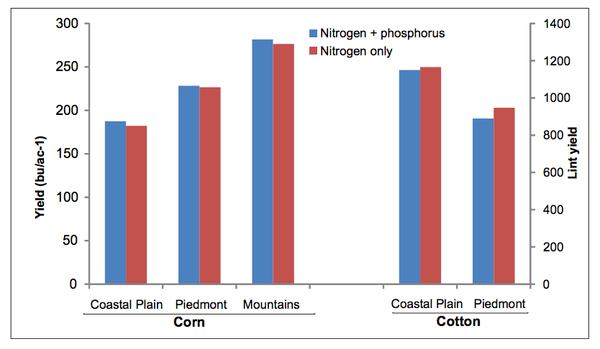What to Watch For: Soil Insects in Organic Tobacco
Organic tobacco acreage has increased throughout the southeast for 2015, and along with this increase has come more questions …


Extension and research at NC State address timely issues impacting our state. Extension delivers trusted information directly into the hands of farmers and agribusinesses, helping them translate knowledge into solutions that grow our economy and communities.
El inglés es el idioma de control de esta página. En la medida en que haya algún conflicto entre la traducción al inglés y la traducción, el inglés prevalece.
Al hacer clic en el enlace de traducción se activa un servicio de traducción gratuito para convertir la página al español. Al igual que con cualquier traducción por Internet, la conversión no es sensible al contexto y puede que no traduzca el texto en su significado original. NC State Extension no garantiza la exactitud del texto traducido. Por favor, tenga en cuenta que algunas aplicaciones y/o servicios pueden no funcionar como se espera cuando se traducen.
Inglês é o idioma de controle desta página. Na medida que haja algum conflito entre o texto original em Inglês e a tradução, o Inglês prevalece.
Ao clicar no link de tradução, um serviço gratuito de tradução será ativado para converter a página para o Português. Como em qualquer tradução pela internet, a conversão não é sensivel ao contexto e pode não ocorrer a tradução para o significado orginal. O serviço de Extensão da Carolina do Norte (NC State Extension) não garante a exatidão do texto traduzido. Por favor, observe que algumas funções ou serviços podem não funcionar como esperado após a tradução.
English is the controlling language of this page. To the extent there is any conflict between the English text and the translation, English controls.
Clicking on the translation link activates a free translation service to convert the page to Spanish. As with any Internet translation, the conversion is not context-sensitive and may not translate the text to its original meaning. NC State Extension does not guarantee the accuracy of the translated text. Please note that some applications and/or services may not function as expected when translated.
Collapse ▲Organic tobacco acreage has increased throughout the southeast for 2015, and along with this increase has come more questions …
A recent post from Barclay Poling at the NC State Strawberry Growers Information Portal highlighted several grower questions about …

Eriococcidae is a family of scale insects commonly called ‘felt scales’. This is a different family than the common …

There has been a lot of discussion about the dos and don’ts of greenhouse fertility management. As we approach …
This link (Soybean 2015) provides a recorded presentation intended for agent training or broadcast in grower meetings. Please report …
Fifteen GAP recertification meetings will be held in North Carolina during January and February of 2015. You can find …
On the heels of its September scientific summit on herbicide resistant weeds, the Weed Science Society of America (WSSA) …
From: Jim Dunphy, Extension Crop Science Specialist, and Steve Koenning, Extension Plant Pathologist, North Carolina State University. Asiatic soybean rust …
O.A. Cleveland discusses why cotton prices have …
Some good cotton defoliation advice from Curtis D. Fountain, Duplin County Agricultural Extension Agent – Field Crops Overview Much of the …

Tobacco harvest and insect populations are winding down. Last week, the grower at our Eastern 1 and 2 sites …

We are at week twenty of scouting. Scouting was done earlier in the week for the Piedmont site, and now they are …

We are at week nineteen of scouting, and harvesting is happening at all locations. The Piedmont site continued with harvesting this week …

We are at week eighteen of scouting. Two of our eastern sites are almost done with harvesting, while harvesting continues …

We are between flights right now (access the trap data and select “corn earworm” on the right), having …
It is week seventeen with our scouting reports, and not much change can be seen. There are still a …

I’ve been getting a lot of questions on soybean insect thresholds. These were covered in a blog article three …

It is week sixteen of our weekly scouting report, and harvest has begun! Most sites are beginning to harvest and …
It is now the fifteenth week of scouting! The budworm pressure has dropped significantly over the past couple of …

Several questions on have come in the during the past week about aphids on tobacco. In most cases, these …

This publication discusses Anthracnose Fruit Rot (Colletotrichum sp.) of blueberries in detail. Included are the …

This factsheet for farmers describes concepts, terminology, and guidelines concerning soil sampling. Proper testing allows …

Phosphorus (P) is the second most important nutrient in crop production but is often found …
This factsheet summarizes the symptoms and management of stubby-root nematodes in soybean in North Carolina.
Lance nematode is not a common problem of soybeans, but can cause local damages in …
The reniform nematode is not a common nematode pressure for soybean growers in North Carolina, …

This soybean disease factsheet covers aerial web blight, a generally minor disease of soybean in …
This factsheet discusses bacterial blight of soybean in North Carolina.